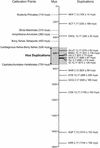Ancient genome duplications did not structure the human Hox-bearing chromosomes
- PMID: 11337473
- PMCID: PMC311105
- DOI: 10.1101/gr.gr-1600r
Ancient genome duplications did not structure the human Hox-bearing chromosomes
Abstract
The fact that there are four homeobox (Hox) clusters in most vertebrates but only one in invertebrates is often cited as evidence for the hypothesis that two rounds of genome duplication by polyploidization occurred early in vertebrate history. In addition, it has been observed in humans and other mammals that numerous gene families include paralogs on two or more of the four Hox-bearing chromosomes (the chromosomes bearing the Hox clusters; i.e., human chromosomes 2, 7, 12, and 17), and the existence of these paralogs has been taken as evidence that these genes were duplicated along with the Hox clusters by polyploidization. We tested this hypothesis by phylogenetic analysis of 42 gene families including members on two or more of the human Hox-bearing chromosomes. In 32 of these families there was evidence against the hypothesis that gene duplication occurred simultaneously with duplication of the Hox clusters. Phylogenies of 14 families supported the occurrence of one or more gene duplications before the origin of vertebrates, and of 15 gene duplication times estimated for gene families evolving in a clock-like manner, only six were dated to the same time period early in vertebrate history during which the Hox clusters duplicated. Furthermore, of gene families duplicated around the same time as the Hox clusters, the majority showed topologies inconsistent with their having duplicated simultaneously with the Hox clusters. The results thus indicate that ancient events of genome duplication, if they occurred at all, did not play an important role in structuring the mammalian Hox-bearing chromosomes.
Figures





Comment in
-
Testing the parsimony test of genome duplications: a counterexample.Genome Res. 2002 Jan;12(1):1-2. doi: 10.1101/gr.214402. Genome Res. 2002. PMID: 11779825 No abstract available.
References
-
- Amores AA, Force YL, Yan L, Joly C, Amemiya A, Fritz RK, Ho J, Langeland V, Prince YL, Wang M, et al. Zebrafish hox clusters and vertebrate genome evolution. Science. 1998;282:1711–1714. - PubMed
-
- Bailey WJ, Kim J, Wagner G, Ruddle FH. Phylogenetic reconstruction of the vertebrate Hox cluster duplication. Mol Biol Evol. 1997;14:843–853. - PubMed
-
- Felsenstein J. Confidence limits on phylogenies: An approach using the bootstrap. Evolution. 1985;39:95–105. - PubMed
Publication types
MeSH terms
Grants and funding
LinkOut - more resources
Full Text Sources
Research Materials
